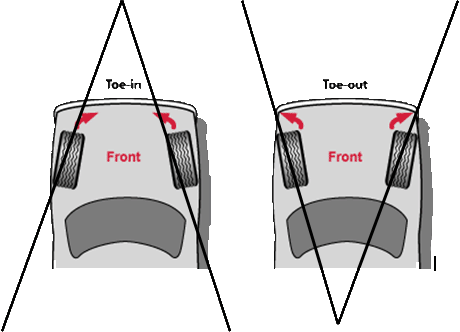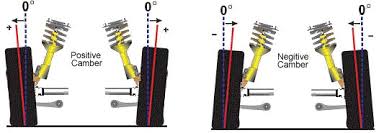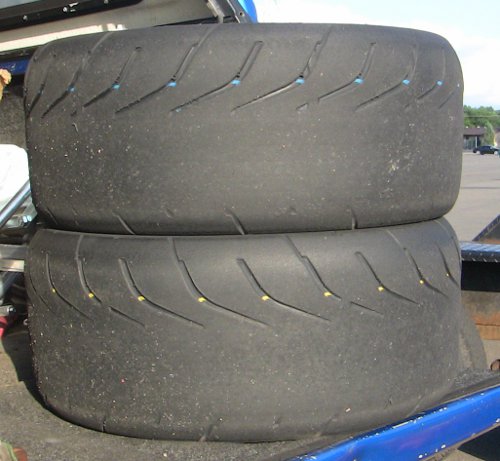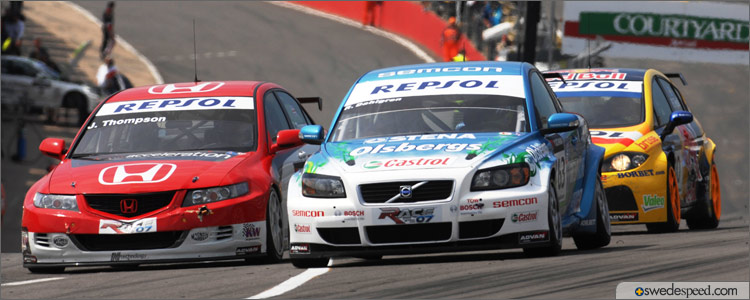Track Alignment
Published: June 26, 2013; updated: October 3, 2017
Today we are going to look at alignment settings specifically as they apply to road course driving.
Toe
Toe is whether the front points of the wheels on the same axle are closer together (positive toe) or further apart (negative toe) than the rear points of the same wheels, when viewed from above.
A car with zero toe has the wheels exactly parallel to each other. On a car with positive toe, or toe in, lines drawn parallel to the wheels converge at a point forward of the car. On a car with negative toe, or toe out, the lines diverge forward of the car.

On a road course front toe primarily affects eagerness of the car to turn and mid-corner understeer/oversteer balance. A car with front toe out will initiate direction changes more easily than a car with front toe in. A car with significant front toe out will feel "darty": a small movement of the steering wheel will be sufficient to get the car to rotate. A car with positive front toe will tend to track straight even in the presence of minor steering wheel movement, which is why street cars often have a bit of positive front toe aligned into them.
The above discussion assumes a car going straight, with equal weight on left and right tires. When the car is in the middle of a corner, and the weight is transfered to the outside tires, front toe has the opposite effect on handling: front toe out produces understeer and a car that resists mid corner direction changes, while front toe in makes the car darty mid corner and may even cause oversteer under power in front wheel drive cars.
To see empirically why this is so, consider toe out. The inside wheel is pointing further into the corner than the car overall. However, mid corner the inside front wheel is unloaded and its contribution to the behavior of the car is minimal. Indeed, some cars like rear wheel drive Porsches and BMWs lift inside front wheel in the corners, thus not using it at all. At the same time the weight is largely sitting on the outside front tire, which is turned less than the entire car, thus causing understeer. The situation is reversed for front toe in, with outside front tire pointing further into the corner and continuing to rotate the car.
Because non-zero front toe produces these opposite behaviors when the car initially turns in and when it is in the middle of a corner, the typical road course setup employs either zero front toe or minimal front toe in either direction.
Rear toe has similar effects to the front toe except, in a rear wheel drive car, rear tires continue to be loaded unevenly through much of the corner exit and not just in the mid corner phase. A car with negative rear toe will want to rotate into turns - the rear end of the car will tend to swing out around the car's center. A car with positive rear toe will tend to keep its rear tires following the front tires; it wil tend to be stable under braking, especially when braking in curved paths. A car with negative rear toe will tend to rotate eagerly under trailbraking, and could easily go into a drift under trailbraking or with aggressive (high steering angle) corner entries.
When exiting corners, negative rear toe will tend to make the car oversteer under throttle (this would be power oversteer). A positive rear toe will tend to make the car understeer - the rear tires will follow the front tires, and will push the front tires forward in a straight line.
A lesser effect of toe, whether front or rear, is drag on the straights. Any positive or negative toe produces more drag than zero toe. On the street, since the overwhelming majority of the time is spent driving in straight lines, the effects of this drag in terms of tire wear may outweigh tire wear due to camber, which is why alignment shops frequently would say that toe is the most important parameter to be correctly set for even tire wear. On the track, tire wear due to toe is generally a less significant consideration than tire wear due to camber. An extreme amount of toe can produce noticeable drag on the straights under braking (front toe) and acceleration (rear toe in a rear wheel drive car, front toe in a front wheel drive car).
Toe Tuning
Some typical toe settings:
- Low to medium power street car: minimally positive toe, front and rear (1/32"-1/16" per side).
- High power street car: minimally positive toe in on non-driven wheels, substantial toe in on driven wheels (1/16"-1/8" per side).
- Low power balanced track car: zero toe, front and rear.
- Medium power RWD track car: zero front toe, minimally positive toe rear.
- High power RWD/AWD track car: zero to minimally positive front toe, substantially positive rear toe.
- FWD track car: zero to substantially negative toe front and rear, depending on car balance, power level and driving style; toe can easily be the most effective way to change the balance of the car.
- Low power drift car: negative toe, front and rear.
- High power drift car: negative toe front, minimally negative to minimally positive toe rear depending on car balance and driving style.
As you can see, the more power a car has the more positive toe it tends to run, especially on the driven wheels. On road courses this is required for stability in high speed corner entries and for the car to exit corners going straight under throttle rather than going into a drift, or powerslide, and tracking straight is obviously a desired characteristic of a street car. That said, road course cars try to minimize toe in to reduce drag and increase tire life.
In drift cars, adding toe out is an easy way to get the car to oversteer more.
Camber
Camber is whether the top points of the wheels are facing inward (negative camber) or outward (positive camber), when viewed from the front.

Camber controls the size of tire contact patch on the respective wheel. Usual car suspension designs result in the outside wheel gaining positive camber in a corner; the harder the car turns, the greater the camber gain. If the car has zero camber standing still (or driving in a straight line), the size of tire contact patch is greatest when the car is not cornering and smallest when the car is cornering. As most cars are limited by grip in corners, making camber negative when the car is standing still results in the tires becoming more vertical in the corners, thus increasing the size of contact patch when it is most needed.
Too much negative camber results in compromised tire contact patch size under braking and acceleration, as well as shifting of this contact patch toward the inside edges of the tires. Hence excessive negative camber normally first manifests in uneven tire wear, with inside edges wearing much quicker than the rest of the tire. A car with excessive negative camber on the driven wheels would tend to spin them under throttle, and a car with excessive front negative camber would tend to lock up the front tires quicker under braking without ABS or have reduced braking performance with ABS. Without a baseline acceleration and braking performance metric with less camber it can be difficult to even realize that excessive camber is causing reduced acceleration or braking performance; fortunately, tire wear would generally obviously indicate that the car is using the insides of the tires excessively and the outsides insufficiently, as the following picture demonstrates:

In RWD cars, optimal camber setting for the front axle depends on how hard the driver corners vs how hard they brake. More advanced drivers tend to corner harder and brake less and therefore are able to effectively utilize more camber on the front wheels. Less experienced drivers who do not corner as hard will want less front camber.
In FWD and to a lesser extend AWD cars, optimal front camber also depends on how hard the driver accelerates and how much power the car has. The tire compound, in particular its optimal temperature range and resistance to heat buildup, also come into play. A FWD car heating up its front tires past their optimal temperature range will compromise all of its performance characteristics - acceleration, braking and turning. This may call for less front camber than a similar RWD car would use. However, if the same FWD car manages to keep its front tires within their ideal temperature envelope, it can be more aggressive with the front camber, which can be useful as FWD cars often need all of the front camber they can get to combat the understeer resulting from their unfavorable weight distribution.
Camber in the rear of a car works on the same principles as camber in the front, but with more nuances. Insufficient rear camber will produce a car that has less rear grip in the corners than it does on the straights, making the car loose on corner entries off throttle. The car may be prone to spinning when trailbraked. Adding camber will make the rear of the car more planted in the corners. Excessive rear camber will produce a reduced rear contact patch size in all conditions, potentially resulting in power oversteer in corner exits in higher power RWD cars, and a car that is loose everywhere in lower power RWD cars. Again, tire wear will probably provide the most clues as to what is happening.
FWD track cars may resort to extreme amounts of rear camber to balance the car by reducing rear end grip. Running a lot of rear camber would also heat up the rear tires more, which may be necessary if the car has a hard time getting enough heat into the rear tires otherwise, such as due to being required by the rules to run the same size tires front and rear. Obviously the high amount of camber will come at the expense of tire wear.

Camber Tuning
Generally speaking:
- Street cars run close to zero camber.
- "Spirited driving" street cars or dual duty street/track cars run -1 to -1.5 degrees of camber, depending primarily on street/track duty split and OEM camber adjustment range.
- Cars driven mostly or exclusively on the track by intermediate-level drivers run -2 to -3 degrees of camber, depending on driver skill and aggression as much as the adjustment potential and handling of the car.
- Dedicated track cars and race cars piloted by advanced-level drivers run -3 to -4 degrees of camber.
Camber values over -3 degrees are normally only found on the front axle.
Some cars, for example Miatas, desire a specific front to rear camber difference to maintain the handling balance. Other cars can have the front and rear camber settings be completely independent.
As long as the camber is not excessive in the sense that it begins to reduce the tire contact patch size under all conditions, making the front camber more negative while keeping the rear camber fixed will make the car oversteer more, while making the rear camber more negative while keeping the front camber fixed will make the car understeer more. A common, though by no means universal, pattern is to have more rear camber than front camber on street cars (to maintain significant understeer) and more front camber than rear camber on track cars (to get more neutral handling).
Caster
Caster is whether the bottom of the suspension is forward of the top of the suspension (positive caster) or rearward (negative caster). Usually cars have positive caster, the question is only how much of it. Caster only applies to the front (steered) axle.
Most of the discussion around caster centers on steering effort. In cars where caster helps avoid positive camber gain in corners, it makes sense to run maximum caster possible.
What You Can Adjust
Depending on your car, you may not be able to adjust all of the parameters. For example, cars with solid rear axles generally cannot adjust rear camber. Many cars require aftermarket camber plates to adjust front camber. Aftermarket control arms are frequently offered to allow adjustment of toe and camber on all corners of a car. Research what adjustments are possible on your vehicle.
Front Toe
Front toe is generally adjustable on all modern cars via tie rods.
Cars with double A-arm front suspensions like Miatas can also adjust the front toe via eccentric bolts.
Rear Toe
Cars with double A-arm rear suspensions like Miatas can adjust the rear toe toe via eccentric bolts. The same eccentrics adjust camber and toe; aftermarket control arms exist which help in separating toe from camber adjustment by adding an additional eccentric.
Cars with trailing arm rear suspensions like Civics can adjust the rear toe via the trailing arm link at the forward end of the trailing arm.
Many cars do not have a way of adjusting the rear toe from the factory, necessitating the replacement of OEM suspension arms with aftermarket control arms or toe links The idea is to replace a fixed length OEM link with one that has either an eccentric bolt or an adjustable rod end.
Front Camber
Cars with double A-arm front suspensions like Miatas can also adjust the front camber via eccentric bolts.
Other cars with double A-arm front suspensions like Civics can replace front control arms with aftermarket adjustable ones, which allow the ball joint to slide in a slot in the control arm, or alternatively replace the ball joints themselves with adjustable ones.
MacPherson strut cars would generally install aftermarket camber/caster plates to adjust camber on the front axle. Camber plates are not applicable to double A-arm cars as in these cars suspension pivot points are control arm attachment points, not shock upper mounts.
Rear Camber
Cars with double A-arm rear suspensions like Miatas can also adjust the rear camber via eccentric bolts. The same eccentrics adjust camber and toe; aftermarket control arms exist which help in separating toe from camber adjustment by adding an additional eccentric.
Many cars do not have a way of adjusting the rear camber from the factory. Same as with rear toe, this adjustment is added by installing aftermarket rear control arms or camber links. As with adjustable camber links, the idea is to replace a fixed length OEM link with one that has either an eccentric bolt or an adjustable rod end.
Caster
Caster is normally adjusted the same way front camber would be - via eccentric bolts, camber/caster plates, etc.
Car Balance
Track cars usually are set up with a touch of understeer. Understeer rather than oversteer is important so that the car can accelerate out of corners; an oversteering car will tend to enter a drift under power which will result in the driver lifting to keep the car on pavement. This understeering tendency however is very slight.
With most production cars set up to strongly understeer from the factory, many track alignment settings are designed to move the cars closer to neutral handling, by making it oversteer more than street settings would. In cases when other suspension components are changed in such a way that the car oversteers (such as installing a huge rear sway bar), alignment can be used to make the car understeer more.
The following will produce a (more) oversteering car:
- Running front camber more negative than rear camber.
- Running rear toe more out/negative.
- Running front toe more out/negative.
Because nonzero toe scrubs speed on the straights, it is usually not desired. Therefore it is a good idea to try to obtain the desired balance via camber and caster adjustments first and only if they are insufficient, use the toe adjustment to balance the car.
As mentioned, many if not most track-only cars have front camber more negative than rear, to make the car's handling more neutral. In contrast, virtually all street cars have more rear camber than front, to make the car understeer.
Tagged: intermediate, advanced
 Visit our
Visit our